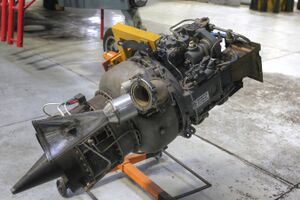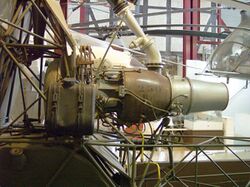Engineering:Turbomeca Palouste
| Palouste | |
|---|---|

| |
| Rolls-Royce license-built Palouste | |
| Type | Gas turbine |
| National origin | France |
| Manufacturer | Turbomeca |
| Major applications | Sud-Ouest Djinn |
The Turbomeca Palouste is a French gas turbine engine, first run in 1952.[1] Designed purely as a compressed air generator, the Palouste was mainly used as a ground-based aircraft engine starter unit. Other uses included rotor tip propulsion for helicopters.
Design and development
Designed and built by Turbomeca, the Palouste was also built under license in United Kingdom by Blackburn and Rolls-Royce. Originally conceived as an aircraft ground support equipment starter gas generator, it was used also as propulsion for the Sud-Ouest Djinn and other tip-jet powered helicopters.
The Palouste was a very simple unit, its primary purpose being to supply a high flow rate of compressed air to start larger jet engines such as the Rolls-Royce Spey as installed in the Blackburn Buccaneer (this aircraft having no onboard starting system).[2] Air from the centrifugal compressor was divided between external supply (known as bleed air) and its own combustion chamber.
Several British naval aircraft were adapted to carry a Palouste in a wing-mounted air starter pod installation to facilitate engine starting when away from base.[3]
A novel use of a surplus Palouste engine was its installation in a custom-built motorcycle known as the Boost Palouste. In 1986 this motorcycle broke an official ACU 1/4 mile speed record at 296 km/h (184 mph). The builder modified the engine to include a primitive afterburner device and noted that pitch changes which occurred during braking and acceleration caused gyroscopic precession handling effects due to the rotating mass of the engine.[4]
Variants
- Palouste IV
- The gas generator used to power the Sud-Ouest S.O.1221 Djinn and other tip-jet helicopters.
- Palouste IVB
- [5]
- Palouste IVC
- [5]
- Palouste IVD
- [5]
- Palouste IVE
- [5]
- Palouste IVF
- [5]
- Palouste 502
- (P.102 and P.104) Blackburn / Bristol Siddeley / Rolls-Royce production for air-starter units.
- Autan
- A development of the Palouste delivering a higher mass flow of compressed air.[6]
- Autan 2
- 1 x axial + 1 x centrifugal compressor stages
Applications
- Bell Model 65
- Fairey Ultra-light Helicopter
- Sud-Ouest Djinn
Specifications (Palouste 4)
Data from Flight :BRITISH POWER UNITS 1953,[7][8]
General characteristics
- Type: Gas generator
- Length: 1,233 mm (48.5 in)
- Diameter: 478 mm (18.8 in)
- Dry weight: 90 kg (200 lb)
Components
- Compressor: Single-stage centrifugal flow
- Combustors: Annular combustion chamber
- Turbine: Two-stage axial flow
- Fuel type: Kerosene
- Oil system: Dry sump, pressure spray at 300 kPa (43 psi)
Performance
- Maximum power output: 190 hp (140 kW) equivalent air horsepower at 33,000 rpm at sea level
- Overall pressure ratio: 3.8:1
- Air mass flow: 3.5 kg/s (7.7 lb/s) at 34,000 rpm
- Turbine inlet temperature: TIT 1,070 K (800 °C) ; JPT 793 K (520 °C) at 34,000 rpm
- Fuel consumption: 110 kg/h (240 lb/h)
- Oil consumption: 0.2 kg/h (0.44 lb/h)
- Thrust-to-weight ratio:
- Air output: 1.1 kg/s (2.4 lb/s) at 350 kPa (51 psi) at 33,000 rpm
See also
Related development
- Turbomeca Artouste
Comparable engines
- Napier Oryx
Related lists
References
- ↑ Gunston 1989, p.170.
- ↑ "PROVING THE BUCCANEER". Flight International 81 (2760): 168. 1 February 1962. https://www.flightglobal.com/pdfarchive/view/1962/1962%20-%200166.html. Retrieved 12 March 2019.
- ↑ "Aircraft Ground Power Units.. .". Flight International 87 (2924): 456. 25 March 1965. http://www.flightglobal.com/pdfarchive/view/1965/1965%20-%200838.html. Retrieved 12 March 2019.
- ↑ The Boost Palouste - jet-pack.co.uk Retrieved: 24 July 2009
- ↑ 5.0 5.1 5.2 5.3 5.4 Wilkinson, Paul H. (1964). Aircraft engines of the World 1964-65 (20th ed.). Washington D.C.: Paul H. Wilkinson. pp. 168.
- ↑ Bridgman, Leonard (1955). Jane's all the World's Aircraft 1955-56. London: Jane's all the World's Aircraft Publishing Co. Ltd..
- ↑ "BRITISH POWER UNITS 1953". Flight LXIV (2328). 3 September 1953. http://www.flightglobal.com/pdfarchive/view/1953/1953%20-%201169.html. Retrieved 12 March 2019.
- ↑ Wilkinson, Paul H. (1957). Aircraft engines of the World 1957 (13th ed.). London: Sir Isaac Pitman & Sons Ltd.. p. 62.
Further reading
- Gunston, Bill (1998). World encyclopaedia of aero engines (4th ed.). Sparkford, Nr Yeovil, Somerset, [England]: Patrick Stephens. ISBN 978-1852605971.
External links
 |



